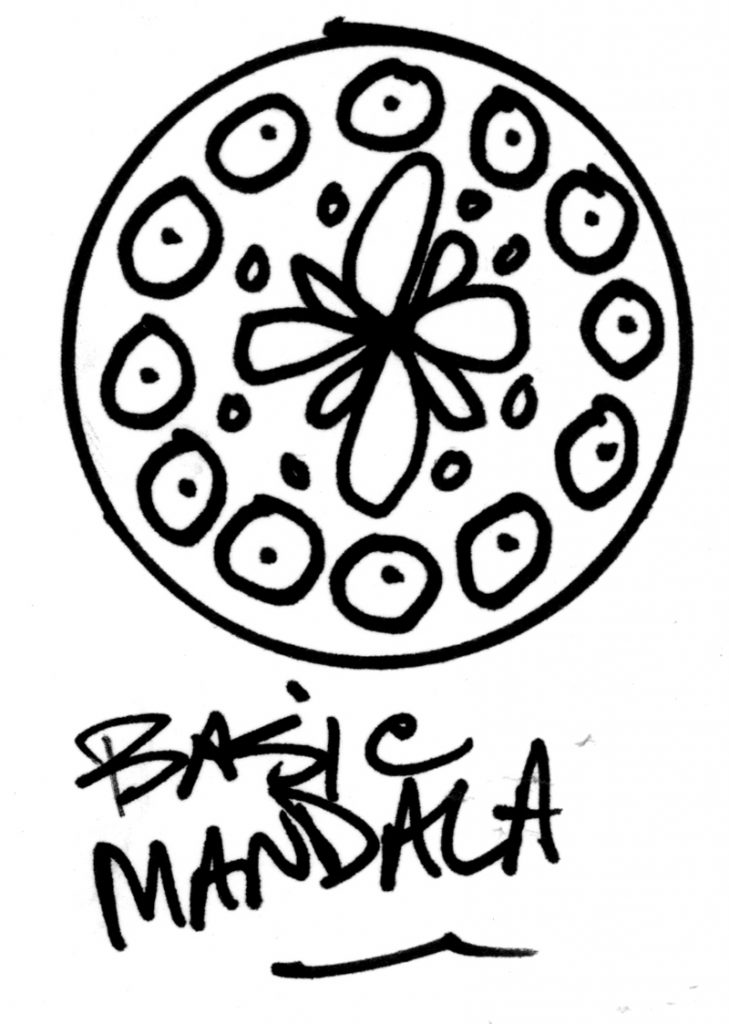
Before I discuss the Healing Mandala, I’d like to point out that, if you’re planning on entering the spiritual game-field of metal embossing sigils, talismans, pendants, rings, pins, headbands, belts, bolo ties and pocket medallions, you will definitely appreciate knowing the following little factoid:
The 24k solid gold disk at 1.4 grams — which is the ideal weight for the small piece, to allow a reasonable retail price-point — when hammered out with a bit of body still left on it, won’t typically fit on the pin-vise without serious compensation and special mountings.
It’s a total pain in the bazonga to try to carve, even if you do manage somehow to put it into a metal harness, because the retaining pins will block your engraving tool and your fingers, making it nearly impossible to complete any cut into the top surface.
However, a 24k solid gold FOIL disk, which is rolled out, not hammered out, can be easily embossed without mounting on a vise — no vise needed for the foil, and the foil could well be an aluminum craft foil, or solid gold foil. Use your fingers to hold onto it.
Your embossing tool can be controlled with one hand, while the engraving tool simply can’t be. You need your other hand to stop the forward movement of the tool, and to guide it onto the target curve or line or gouge.
Funny thing is, once the gold foil or heavier gold slab is inside the bezel and the protective quartz-glass crystals are in place, you can’t tell whether it’s foil or a thicker beaten-out gold disk. Unless you take the locket apart, the foil gold and the heavier “token” weight gold disk, when viewed inside the locket, look exactly the same.
Even the slight weight difference can’t be told by hand — you’d have to weigh it on a very sensitive scale to pick up the weight differential. The bezel itself, because it’s made of solid 14k gold, weighs plenty enough by itself without the need for a weight-boost from the disk inside it.
The rolled-out foil gold costs about 1/5 down to 1/10 of what the gold token would cost, meaning that you could deliver a solid gold product for much less cost and much lower cost to the client, without sacrificing anything except a little gold-weight, which would be undetectable in any case.
I make all my SELLING SAMPLES out of craft foil, so I don’t have to spend hours of my time keeping a careful eye on my merchandise.
If a customer wants to order something in 24k gold, I write up a pre-paid custom order for a piece in 24k gold, including a 14k solid gold coin-edged or rope bezel — those are the two choices, unless they want to spend some serious money on a totally custom bezel.
If you’re at all good at the embossing craft, you’ll want to carry a small 24k gold disk custom kit with you just about everywhere but the shower, and even then, you might be tempted. You won’t need to carry more than three disks at a time.
If you’re not yet a metal-embossing artisan, you won’t have a clue about this, but the fact is that it’s only when you try to sell the things you make that you begin to get an idea that your work could improve.
Of course, with low self-esteem at work in you 24/7/365 as a result of being born in a human body and therefore subject to the Bot-Brain’s limited mental resources, resulting in the aforementioned “low self-esteem”, with THAT crap working on you constantly, you’ll no doubt have already formed the opinion that your work is shit, and not the good kind of shit that the kids rave about.
But when you try to sell the things, you get feedback — sometimes verbal, sometimes body languaging, sometimes just a series of blank expressions signifying that the customer just doesn’t get what you’re trying to put down in front of them.
If you’re able and willing to learn, meaning you don’t have an ego problem with failing at something you’ve never tried before, you have a good chance of improving your product to the point where it sells on a regular basis, which is one way of telling that you’re “on”.
Selling is not the only indicator that you’re “on”, but it IS one of several indicators you could use to steer yourself on a spiritual course every minute of every day you’re given to work.
Well, we’ve established a few points about metal embossing. Let’s take a look at what makes a Mandala, shall we?
First of all, we start with a circle, which is the defining boundary of your Mandala, because it’s going onto a circular disk that measures 38mm across, the size of a U.S. Silver Dollar.
Note the word “silver” in that phrase. It doesn’t apply to any other dollar, and even then, there’s a slight difference between the Morgan Dollar and the Peace Dollar — enough to warrant two distinct sizes of “dollar” bezel.
By the way, one way to sell Morgan and Peace Dollars is IN A BEZEL, but beware — they won’t pay for the bezel, just the dollar, so the bezel has to cost you next-to-nothing, and that CAN be arranged.
You can put a fairly nice coin-edged bezel around a silver dollar for less than you’d believe, if you buy in quantity, which is the only way to get the edge on a profit-margin of any kind with any product or service — it’s all about delivering good quality for a REASONABLE price, which of course puts you out of the market when compared with something that’s stamped “Made in China”.
Am I picking on China there? Sure I am. I calls ’em the way I see ’em, bud. (“Bud” is the previous millenium’s word for “bro”.)
Look at the “field” of the Mandala. It is round, flat and … but wait! Did you remember to GENTLY roll your embossing tool over the BACK of the foil, to smooth it out and make it perfect?
Good.
Your next move is to flip the foil over so the gold side faces “up”, toward you. LIGHTLY roll your embossing tool over it to flatten it, or use your fingers to lightly press the foil disk more or less flat against the backing surface — the cardboard backing board on which you emboss your foil.
You don’t automatically get one of those in the kit — I include a wooden stick that you can use until you cough up the coupla bucks for the Basic Tool Kit, which I’m ordering on your behalf and on behalf of your metal embossing class students.
Okay, back to the Mandala… Let’s look at the target design:

You start out by making the surrounding circle first, if wanted. Then you’d put in one circle up at the top, one at the bottom, one to the right, one to the left, then fill in two circles each, between them, to make it come out right, however, you may have other ideas.
You’d then add your fleur-de-lys or lotus in the center, all in a single line.
Next, you’ll want to add circles or corn or other things in the intermediate field between the outer and inner circles.
If you want to speckle any of these, you’d flip the piece over so it’s silver-colored side up, then tack in the spiny points to emboss them on the obverse.
Okay, Now you can add your outer dots, signature and date to the edge of the piece, then mount it in a bezel or an acrylic capsule or in a cardboard flip, and it’s ready for sale or delivery if you’ve already sold it from the sample design in your sales notebook which, by the way, should be somewhat fancy and have an easy-carry handle and zipper around the pages to prevent fallout.
Yes, the flips can fall out of the pages, which is something you get used to and eventually something for which you automatically compensate when you carry them around. They are vulnerable to droppage, so if you leave the zipper open, you might very well leave a trail of flips behind you as you travel across town or wander in a mall.
https://youtu.be/w4y8IdyrcUE
See You At The Top!!!
gorby

